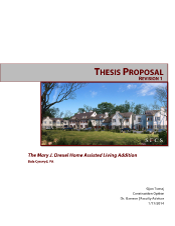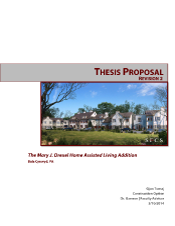The Thesis Proposal is intended to identify four technical analyses topics that will be investigated throughout the Spring semester. Through these analyses, the main focus will be on schedule compression, value engineering, and research. The analyses and breadth topics that will investigated for the Mary J. Drexel Project are outlined below.
| |
|
|
|
|
| |
|
|
|
 |
|
 |
|
|
Thesis Proposal - 12/16/13 |
|
Revision 1 - 1/23/14 |
|
Revision 2 - 3/10/14 |
|
| |
| -- Analysis #1: Project Sequencing -- |
|
With most of the emphasis of the project focused on cost and quality, not much emphasis was considered regarding the project schedule. Much of the construction therefore was not sequenced in a manner that would have been efficient, such as overlapping construction activities. Many activities were scheduled to start after the previous one was completed. This analysis will focus on re-sequencing the current project schedule which will shorten the schedule, resulting in a decrease in general condition costs for the project. |
| |
|
| -- Analysis #2: MEP Prefabrication -- |
|
Multi-trade prefabrication allows for multiple building systems to be constructed in an environment off-site while other building systems are being constructed on-site. Many unforeseen delays occurred throughout this project causing the MEP trades to increase manpower in order to meet the schedule. To avoid this, the implementation of prefabricated MEP corridor racks would have been beneficial. This will allow for reduced site congestion while improving productivity results and efficiency. Although there may be costs associated with prefabrication techniques, cost savings are available through the reduction of the schedule. |
| |
|
| -- Analysis #3: Green Roof Implementation-- |
|
Many value engineering efforts were taken into consideration for this project. Although many of these efforts focused on lowering initial capital costs, not as much consideration was given to the life-cycle costs of the changes that were implemented. The implementation of a green roof would have been a great consideration for this project instead of the EPDM system that was chosen. With the exceptional performance of a green roof regarding reducing energy costs and improving human health and comfort, the long-term economic benefits would definitely outweigh the start-up costs. An acoustical and structural breadth will also be performed for this analysis. |
| |
|
| -- Analysis #4: Alternate Delivery Method-- |
|
Utilizing two different delivery methods caused delays due to design changes as well as coordination and communication issues. Research will be performed of the feasibility of using another delivery approach such as Integrated Project Delivery. The MEP systems were Design-Build while all other systems were approached with a Design-Bid-Build approach. Integrating more trades and team members into the preconstruction process would have been beneficial and any complications that may have arisen would have been resolved more efficiently.
|
| |
|
| -- Breadth #1: Structural Analysis [Incorporated into Analysis #3] -- |
|
The existing structural system of the project consists of load-bearing metal panel walls. Incorporating a load-bearing green roof system will require a structural analysis of the additional loads of the roof as compared to the EPDM roof system that was value engineered to be used.
Research on the different types of green roof systems will be conducted and calculations will be performed to determine if the existing load-bearing structural systems can support the dead load of the green roof. Additional support such as the metal roof deck and foundation may need to be redesigned to efficiently support the new green roof system. This will be followed with evaluating any new costs and any schedule impacts that may arise.
Deliverables will include:
- Analysis of existing load bearing structure using a representative bay of one bedroom unit.
- Analysis of the metal roof deck, load bearing panels, and foundation.
- Conclusions will be made regarding whether the existing system can support the green roof and a recommendation will be made if the existing structure is inadequate.
|
| |
|
| -- Breadth #2: Acoustical Analysis [Incorporated into Analysis #3] -- |
|
| |
The incorporation of the green roof system over an EPDM roof system should result in better acoustical performance. A study of sound transmission of the green roof system will be compared to that of the EPDM system. This will require finding the sound transmission class (STC) of the system components and performing a full sound transmission loss evaluation comparing the current design and the green roof design. This value engineering analysis will determine if implementing the green roof system will create a better living experience for the senior living residents in their living units.
Deliverables will include:
- Sound Transmission Loss calculations at 125 – 4500 Hz frequency range to determine variations of sound levels in resident rooms.
- Calculating and comparing STC ratings using transmission loss data found at different frequencies.
- Conclusion comparing calculations.
|
| |
|